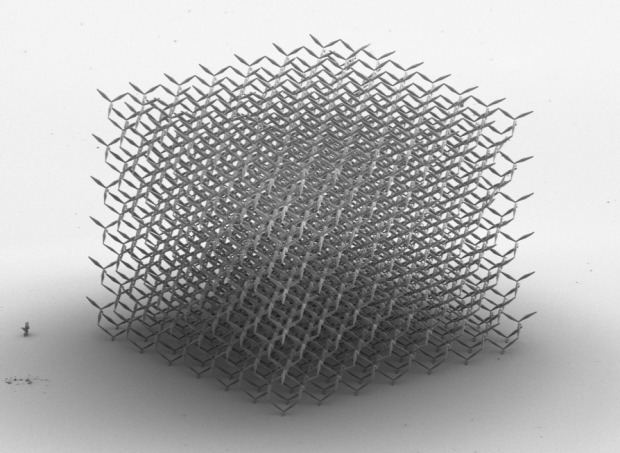 | ||
Mechanical metamaterials are artificial structures with mechanical properties defined by their structure rather than their composition. They can be seen as a counterpart to the rather well-known family of optical metamaterials and include acoustic metamaterials as a special case of vanishing shear. Their mechanical properties can be designed to have values which cannot be found in nature.
Contents
Acoustic / phononic metamaterials
Acoustic or phononic metamaterials can exhibit acoustic properties not found in nature, such as negative effective bulk modulus, negative effective mass density, or double negativity. They find use in (mostly still purely scientific) applications like acoustic subwavelength imaging, superlensing, negative refraction or transformation acoustics.
Materials with negative Poisson's ratio (auxetics)
Poisson's ratio defines how a material expands (or contracts) transversely when being compressed longitudinally. While most natural materials have a positive Poisson's ratio (coinciding with our intuitive idea that by compressing a material it must expand in the orthogonal direction), a family of extreme materials known as auxetic materials can exhibit Poisson's ratios below zero. Examples of these can be found in nature, or fabricated, and often consist of a low-volume microstructure that grants the extreme properties to the bulk material. Simple designs of composites possessing negative Poisson's ratio (inverted hexagonal periodicity cell) were published in 1985. In addition, certain origami folds are also known to exhibit negative Poisson's ratio.
Publications related to mechanical metamaterials incluce, and.
Metamaterials with negative longitudinal and volume compressibility transitions
In a closed thermodynamic system in equilibrium, both the longitudinal and volumetric compressibility are necessarily non-negative because of stability constraints. For this reason, when tensioned, ordinary materials expand along the direction of the applied force. It has been shown, however, that metamaterials can be designed to exhibit negative compressibility transitions, during which the material undergoes contraction when tensioned (or expansion when pressured). When subjected to isotropic stresses, these metamaterials also exhibit negative volumetric compressibility transitions. In this class of metamaterials, the negative response is along the direction of the applied force, which distinguishes these materials from those that exhibit negative transversal response (such as in the study of negative Poisson's ratio).
Pentamode metamaterials or meta-fluids
A pentamode metamaterial is an artificial three-dimensional structure which, despite being a solid, ideally behaves like a fluid. Thus, it has a finite bulk but vanishing shear modulus, or in other words it is hard to compress yet easy to deform. Speaking in a more mathematical way, pentamode metamaterials have an elasticity tensor with only one non-zero eigenvalue and five (penta) vanishing eigenvalues.
Pentamode structures have been proposed theoretically by G. W. Milton in 1995 but have not been fabricated until early 2012. According to theory, pentamode metamaterials can be used as the building blocks for materials with completely arbitrary elastic properties. Anisotropic versions of pentamode structures are a candidate for transformation elastodynamics and elastodynamic cloaking.
